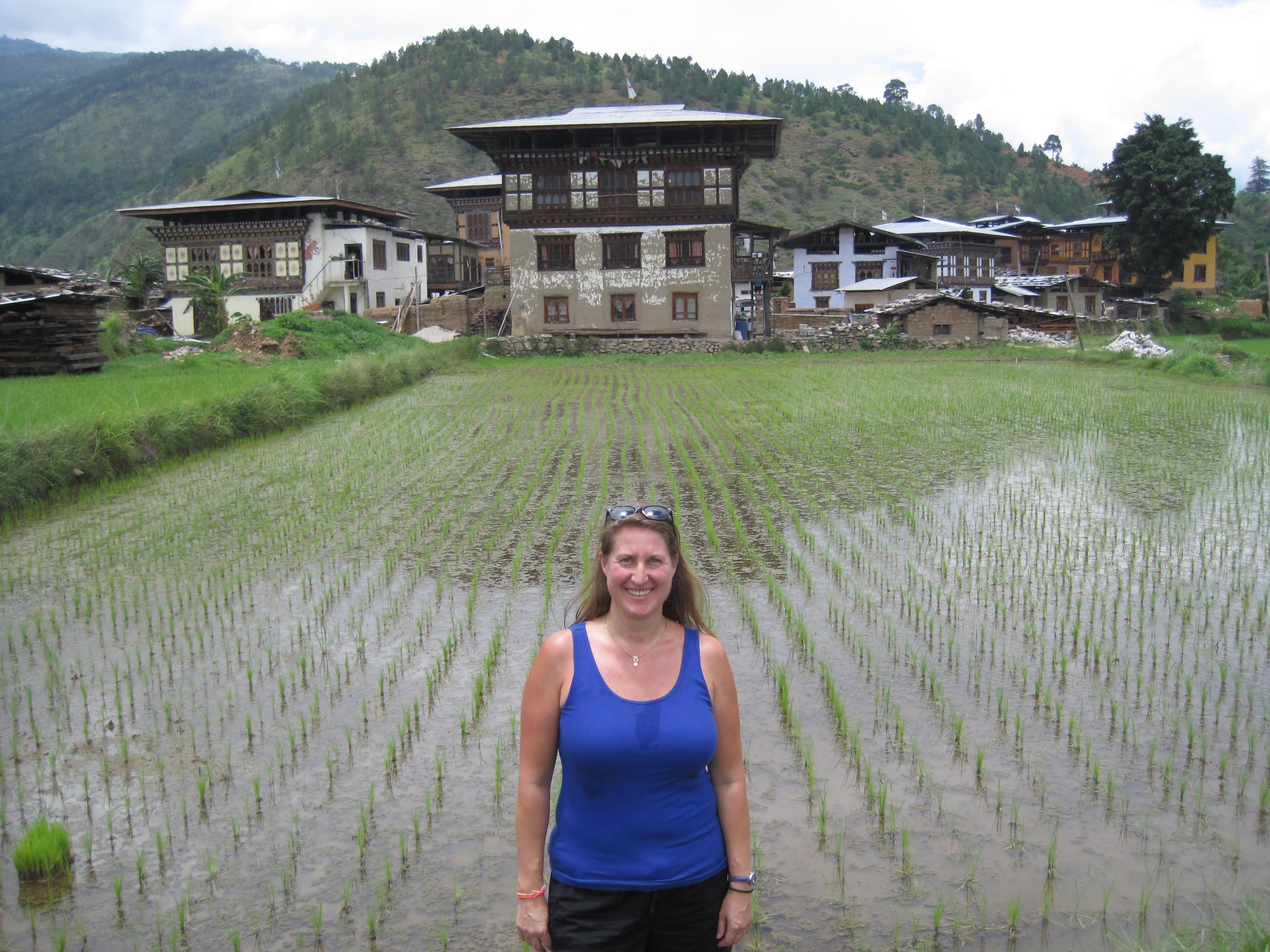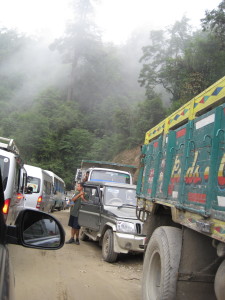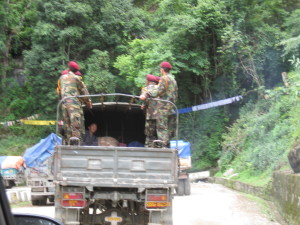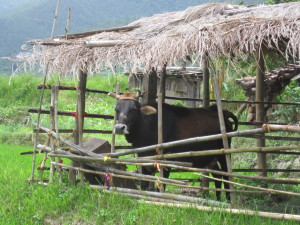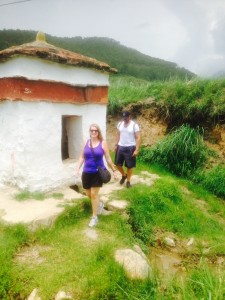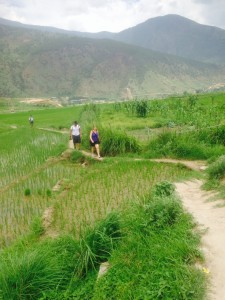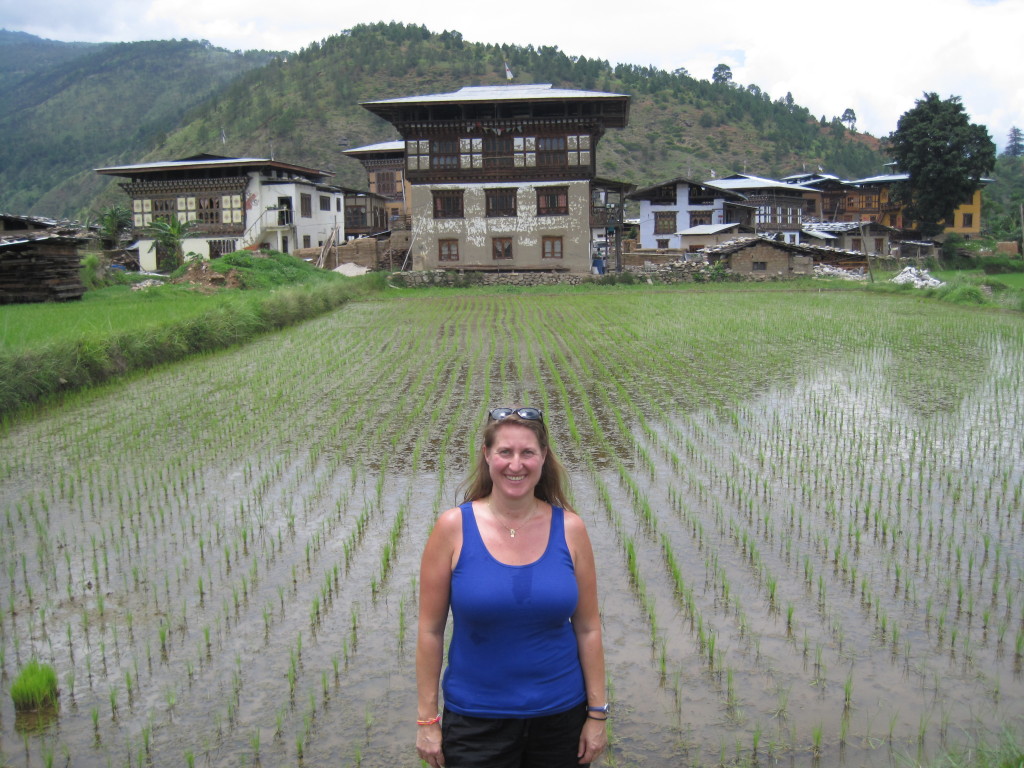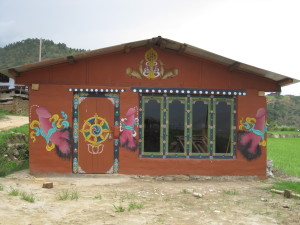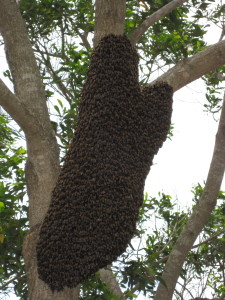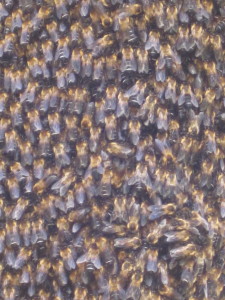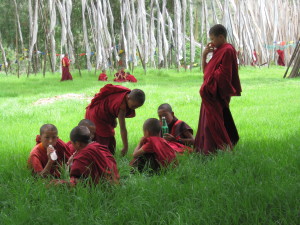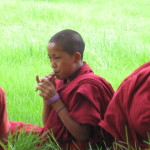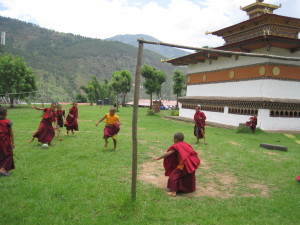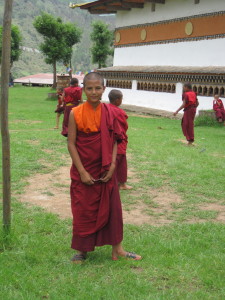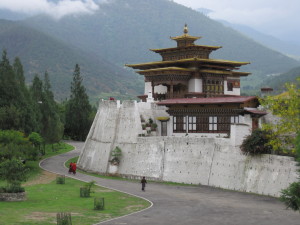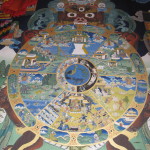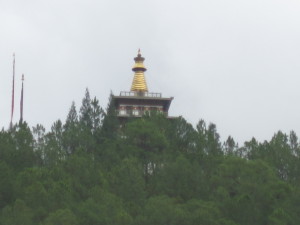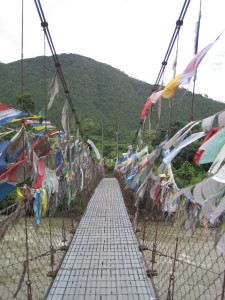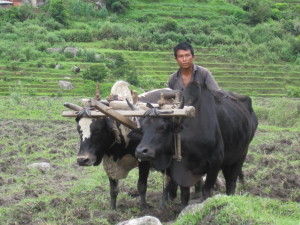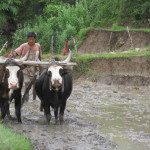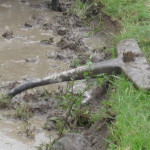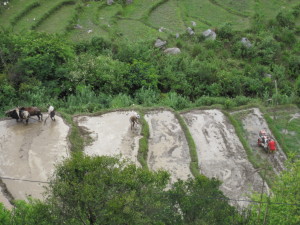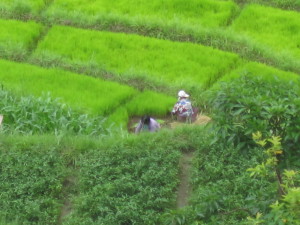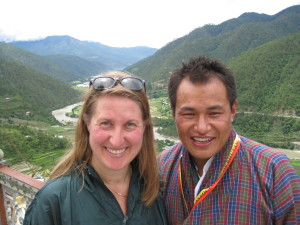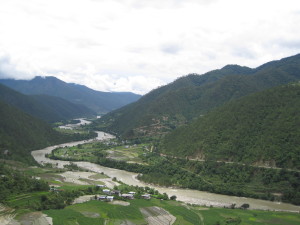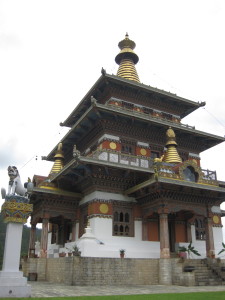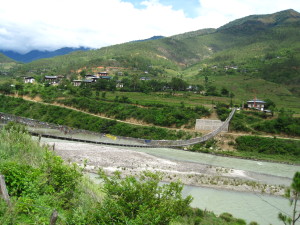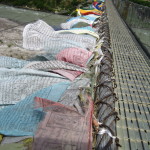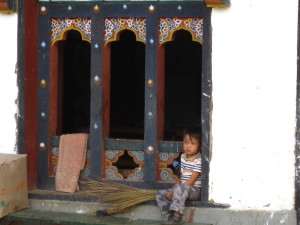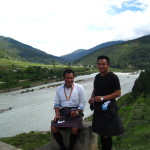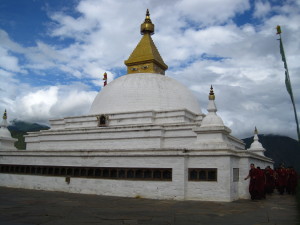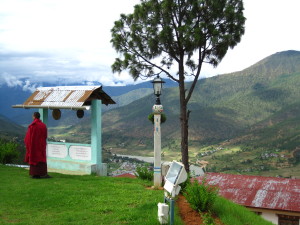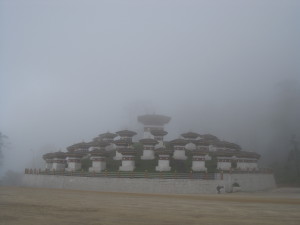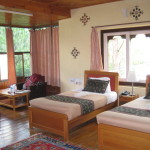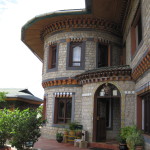The Crazy Drive from Thimphu to Punakha:
We were warned the roads were “not so nice” as the government has been working on widening the pass over the mountain. With this widening project, the roads were only open from 6:00-8:00am in the direction we were going, so we had to wake up early to get over the pass. We figured no big deal, we would be on the road by 7:00am and would stop at the top of the pass for breakfast. What we quickly learned is the road is basically all dirt (or now it’s mud since it’s the beginning of rainy season) and it took our very skilled driver Jimmy a lot of concentration to drive across this pass (of and he was driving a manual through this muddy pass). I was glad I wasn’t driving as it didn’t look fun. After about 40 minutes of turns, curves and a whole lot of bumps in the car, we got through half the Dolchula Pass and noticed the other direction of cars weren’t being allowed to drive through. It turned into a major car pileup on the other side. It was quite the sight to see as the two lane road somehow was now three or four wide as everyone was trying to get closer to the front of the pack and was making up space on the tiny road. Then people just got out of their cars and started to socialize while they waited for the pass to open. Luckily, we were able to pass and go down within a few minutes, but here are some photos of what we saw.

Crazy traffic jam when they closed the pass one direction to do work. Luckily we just made it through before they closed it
In addition, we got stuck behind major construction on the pass. These big tractors would just go about doing the work and often they got quite close to use as we drove by. We were lucky as a military van pulled in front of us and our driver Jimmy just started to follow him so we got almost an express pass behind the military and kept moving. I had to ask Pema…, “How long has the government been working the widening project as this is just a mess with all the rain and mud.” He told me it’s been about 7-8 months and there was still a lot of work to be done. This was surprising as the country was just entering the rainy season, so it’s only going to get worse. We ran into some traffic jams with oncoming buses and cars, and it was more comical than anything else.
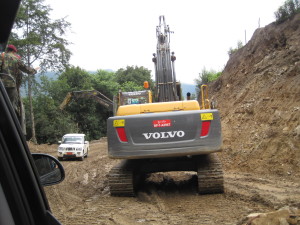
The Dolchala Pass – is was a muddy mess as they are trying to widen and when it rains, it turns to mud. Rough ride
In the end…our 2.5 hour drive over the pass ended in the beautiful (and very hot) Punakha Valley and this was where we would spend out next two days.
Punakha Valley
When we arrived in the Punakha Valley, we started to walk through a small village, through local rice fields and eventually reached the Chime Monastery. As we were walking through the village, we were able to see how the local townspeople lived and it was a very simple life. There were livestock roaming freely, or this cow was tied up in a makeshift barn enclosure.
We also were able to walk along the rice fields and see all the different of the rice from seeds to almost full grown which was really beautiful.
Do you want a Large Penis Painted on your Home?
This town is also known to be a place both locals and foreigners come to make a pilgrimage if they haven’t been fortunate to become pregnant. So many of the buildings and locals homes had very large phallus pictures painted on the outside as a sign of fertility. Here was one I took a photo of but there were many in this town. Plus many of the shops sold lots of wooden idols for visitors to take home in hopes of fertility.
Crazy Bee Hive
As we reached the bottom of the Monastery, Pema warned us to be careful as there was a giant bee hive. I was expecting to see more of a round hive like we see at home, but here, the bees essentially live on top of each other. It was a windy day, so when the wind picked up, you would see the entire group of bees sway back and forth. It was such a sight, I had to get a close up of the bees. To be a little funny…I said to Mark and Pema that we should play a game. I would throw a rock at the bee hive. Whoever ran the slowest would lose. Of course I didn’t as that would have been a crazy bee swarm.
Chime Monastery
We finally reached the Chime Monastery, which was a Buddhist monastery and was built in 1499. When walked up, we first came across this old man sitting by this wheel. He looked so peaceful sitting there.
We continued to the top of the hill and were met by a few groups of young kids all dressed in their red robes. The youngest kids were sitting in the grass practicing playing an instrument. What was interesting about this when I looked closer is they were all blowing into old water bottles or soda bottles with straws. Pema told us they practiced making the noise with these water bottles before they moved onto the real instrument. We saw some of the older boys practicing on the real instrument in another group on the grass.
We just sat there watching the boys play and then later horse around in the grass. There was something so fun watching them play. When we came out of the temple, they were all playing soccer together in their robes, and we just enjoyed a little soccer. Pema actually jumped in and played with them for a while as well.
Here is a little more information I found on the monastery and history behind the phallus and fertility pilgrimage:
- In founding the site it is said that Lama Kunley subdued a demon of Dochu La with his “magic thunderbolt of wisdom” and trapped it in a rock. He was known as the “Mad Saint” for his unorthodox ways of teaching Buddhism by singing, humor and outrageous behavior, which amounted to being bizarre, shocking and with sexual overtones. He is also the saint who advocated the use of phallus symbols as paintings on walls and as flying carved wooden phalluses on house tops at four corners of the eves.
- The monastery is the repository of the original wooden symbol of phallus that Kunley brought from Tibet. This wooden phallus is decorated with a silver handle and is used to bless people who visit the monastery on pilgrimage, particularly women seeking blessings to beget children. The tradition at the monastery is to strike pilgrims on the head with a 10 inch wooden phallus. Traditionally symbols of an erect penis in Bhutan have been intended to drive away the evil eye and malicious gossip.
**When we returned to the temple and made an offering, one of the monks did use this 10 inch wooden phallus to bless us. Quite an interesting experience, but all par for the course.
Punakha Dzong:
We spent the afternoon visiting the Punakha Dzong which means “the palace of great happiness or bliss”. This was built in 1637 and is the second oldest and second largest dzong in Bhutan. It’s known as one of its most majestic structures and it was quite nice. Pema also spent a lot of time explaining the whole story of Buddha inside as this temple has a really great mural on the wall that describes this. So it was more educational and easy to follow with the pictures in the mural. We also spent some time learning about this circle of life in pictures.
Khamsum Yuelley Namgyal Chorten
Khamsum Yulley Namgyal stands majestically on a strategic ridge above the Punakha valley. It was built over a period of 9 years, Bhutanese craftsmen including carpenters, painters, and sculptors consulted holy scriptures rather than engineering manuals, to construct this 4-storey temple.
Pema told us we were going to hike to the top of the hill and would be rewarded with a great view. He said it would take about an hour and when we arrived and looked up, it was pretty high up and looked like a very healthy hike. As we started our journey across a short suspension bridge, we were able to walk along some local farmers that were using oxen to plow rice fields.
On the return walk, we came across some local farms and rice fields. We even got to witness the old school and new school farmers. On two neighboring farms, we saw one farmer using two oxen to plow his rice fields, where the neighbor was using a more modern electric machine. Both were doing the same job, and it was interesting to watch the different processes.
The Best View of the Punakha Valley
Once we arrived at the top of the mountain, we were able to enter the temple and climb the four floors to the top for one of the best views of the valley. The hike up was totally worth the view at the end and you could see everything from that viewing point.
The longest suspension bridge in Bhutan
After having a delightful lunch down by the river, we were off to see the longest suspension bridge in Bhutan. Once we crossed it, we got to watch some local kids playing and enjoy the river. One of the things I like most of the bridges is all the prayer flags that are hanging off of the bridge.
Laptshakha Nunnery
This final nunnery was quite special as a group of visiting monks came at the same time. So they were also guests and were able to enjoy the nunnery with us. It was fun to watch them take photos and take it all in along with us. I also was able to get some photos with these monks in their red robes around the stupa.
Dochula Pass
As we left the Punahka Valley, we came to the top of the Dolchula Pass again. We were hoping for a clearer day, as it was pretty overcast when we came two days earlier. Unfortunately, it was very overcast this day as well. We were told on a good day, you could see for a long way. At least we could see the 108 chortens . These chortens were built by Queen Mother to honor the Bhutanese soldiers who were killed when fighting the Indian rebels in 2003. Bhutan was forced to repel the rebels as failing to do so, India threatened to enter the country to do so themselves. The 4th King led a volunteer army of about 7,000 men to force the rebels to exit the country. Though Bhutanese have wanted to build this chortens to mark the victory of Bhutanese army, the King has rejected this offer and instead uses the chortens to commemorate the deceased.
So that was it for our time in the Punakha Valley. It was very much worth the drive over the pass to get there. It was a very different view to Bhutan and a great two days.
Bhutan Flag:
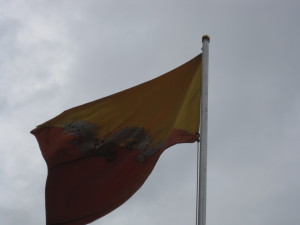
Bhutan’s National Flag. One of the few countries that it was hard to find as it doesn’t fly everywhere.
Logistics:
Tour Company: Please contact Pema as he is the owner of Bhutan Leading Travel and he was the guide that took us out on our 8 days. He has been leading tours since 1998 and is a Sr. Cultural and Trekking Guide for Bhutan. You can email Pema at: pematangbi@gmail.com or visit the website at www.bhutanleadingtravel.com
Meri Puensum Resort – This resort was ok. The location and staff were great, but the food was less than great. Pema warned us of the food issues, but still said it was one of the best hotel options for this part of town and the room was really nice.
www.meripuensum.bt/punakha
